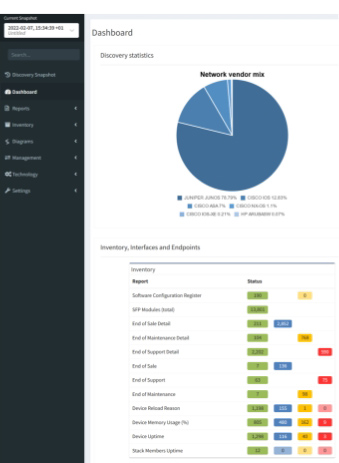

It’s clear we’re not putting the Artificial Intelligence toothpaste back in the tube. The last year has only seen an acceleration of AI concepts and experiments becoming applicable to enterprise workflows. If it’s improving outcomes and profitability, why not push forward, right? Uh… right? Well, this is not the place to argue for that philosophy and its potential realities. However, we can certainly speak on the complexity that AI/ML driven process adds to the network that underpins these applications and services. Network automation, artificial intelligence...with every amazing step forward, a new thread of complexity to weave into the fabric of enterprise networking. Somewhere, right now, a network engineer is grappling with the additional demands these processes place on an already massively complex system. Let's explore what's making their day more difficult.
Note: Most of the challenges discussed here apply across industries, but it’s helpful to frame these issues practically, hence the industry-based lens. Understanding the problem in its true context is the first step toward finding solutions.
We’ll start with where improving outcomes is most personal - our health. Hospitals, clinics, and other medical facilities have been jolted into embracing technologies they were more conservative about pre-pandemic. The strain on healthcare systems and growing patient needs and expectations spurred this embracing of technology-based solutions to medical problems.

Democratizing care access via more and better telehealth services, automated patient imaging and diagnostics, remote patient monitoring, robot-assisted surgery, automated drug administration, patient record updates… it’s clear that done right, these initiatives can take pressure off historically overworked doctors, nurses, radiologists, and technicians and improve healthcare outcomes. “Done right” is key, I’m sure you’ll argue, when you’re the one attached to an IV and a computer is selecting your medication and dosage.
So, what lies beneath these health-tech marvels? Here are just three points to consider:
Our frameworks for learning are fundamentally changing with the mainstream use of AI technologies. It can start with simply automating repetitive tasks – grading, scheduling, planning - to free up time for educators. However, it also transforms the way students learn and what they learn. AI can create personalized learning paths and curriculums based on student preference or ability, speed up tailored feedback, and use historical data to track progress and determine knowledge and skills gaps more accurately. Generating educational content has become faster thanks to AI, and access to education has improved with AI-powered translation. Chatbots available 24/7 means students can ask questions whenever they need to, and get valuable answers.

What does this mean for network engineers managing networks for universities, schools, and Edutech companies?

Though somewhat stymied by heavy regulation, Finance/Fintech enterprises have long sought to harness the power of AI to wade through data and make better predictions, optimize processes, improve customer experience, and enhance services.
There is a global move toward mobile-first banking, and it's key that banks rise to the occasion in terms of customer experience; AI can personalize and enhance these experiences with chatbots, customized product recommendations, and improvements based on customer analytics. AI is also used for better fraud detection and prevention, alerting teams to anomalies in transaction patterns quickly, and ultimately protecting the business.

So, what do these wonderful advancements mean for teams operating the IT networks that allow these financial institutions to run?
Artificial intelligence and machine learning are too powerful to leave any industry completely untouched. In just these three examples, the emerging patterns are clear. Enterprises need to understand the impact of AI/ML on their IT networks; the business-critical backbone of their operation. If we expect engineering teams to maintain resilience and performance to support the future-focused enterprise, they need tooling that is up to the challenge.
AI with network assurance as a measure to continuously validate network state is a tool network teams can use to meet this challenge. To see how IP Fabric can offer end-to-end enterprise network visibility without making your life more complicated, try a self-guided demo today or request a tailored demo from our team.
It’s clear we’re not putting the Artificial Intelligence toothpaste back in the tube. The last year has only seen an acceleration of AI concepts and experiments becoming applicable to enterprise workflows. If it’s improving outcomes and profitability, why not push forward, right? Uh… right? Well, this is not the place to argue for that philosophy and its potential realities. However, we can certainly speak on the complexity that AI/ML driven process adds to the network that underpins these applications and services. Network automation, artificial intelligence...with every amazing step forward, a new thread of complexity to weave into the fabric of enterprise networking. Somewhere, right now, a network engineer is grappling with the additional demands these processes place on an already massively complex system. Let's explore what's making their day more difficult.
Note: Most of the challenges discussed here apply across industries, but it’s helpful to frame these issues practically, hence the industry-based lens. Understanding the problem in its true context is the first step toward finding solutions.
We’ll start with where improving outcomes is most personal - our health. Hospitals, clinics, and other medical facilities have been jolted into embracing technologies they were more conservative about pre-pandemic. The strain on healthcare systems and growing patient needs and expectations spurred this embracing of technology-based solutions to medical problems.

Democratizing care access via more and better telehealth services, automated patient imaging and diagnostics, remote patient monitoring, robot-assisted surgery, automated drug administration, patient record updates… it’s clear that done right, these initiatives can take pressure off historically overworked doctors, nurses, radiologists, and technicians and improve healthcare outcomes. “Done right” is key, I’m sure you’ll argue, when you’re the one attached to an IV and a computer is selecting your medication and dosage.
So, what lies beneath these health-tech marvels? Here are just three points to consider:
Our frameworks for learning are fundamentally changing with the mainstream use of AI technologies. It can start with simply automating repetitive tasks – grading, scheduling, planning - to free up time for educators. However, it also transforms the way students learn and what they learn. AI can create personalized learning paths and curriculums based on student preference or ability, speed up tailored feedback, and use historical data to track progress and determine knowledge and skills gaps more accurately. Generating educational content has become faster thanks to AI, and access to education has improved with AI-powered translation. Chatbots available 24/7 means students can ask questions whenever they need to, and get valuable answers.

What does this mean for network engineers managing networks for universities, schools, and Edutech companies?

Though somewhat stymied by heavy regulation, Finance/Fintech enterprises have long sought to harness the power of AI to wade through data and make better predictions, optimize processes, improve customer experience, and enhance services.
There is a global move toward mobile-first banking, and it's key that banks rise to the occasion in terms of customer experience; AI can personalize and enhance these experiences with chatbots, customized product recommendations, and improvements based on customer analytics. AI is also used for better fraud detection and prevention, alerting teams to anomalies in transaction patterns quickly, and ultimately protecting the business.

So, what do these wonderful advancements mean for teams operating the IT networks that allow these financial institutions to run?
Artificial intelligence and machine learning are too powerful to leave any industry completely untouched. In just these three examples, the emerging patterns are clear. Enterprises need to understand the impact of AI/ML on their IT networks; the business-critical backbone of their operation. If we expect engineering teams to maintain resilience and performance to support the future-focused enterprise, they need tooling that is up to the challenge.
AI with network assurance as a measure to continuously validate network state is a tool network teams can use to meet this challenge. To see how IP Fabric can offer end-to-end enterprise network visibility without making your life more complicated, try a self-guided demo today or request a tailored demo from our team.




